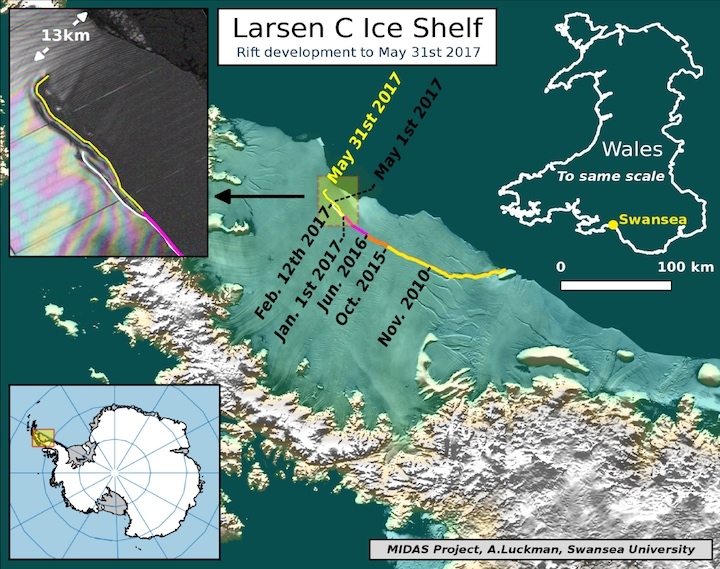Antarctica's Larsen C Iceberg Is on the Brink of Breaking Off

The saga of the Larsen C crack is about reach its stunning conclusion. Scientists have watched a rift grow along one of Antarctica's ice shelves for years. Now it's in the final days of cutting off a piece of ice that will be one of the largest icebergs ever recorded.
It's the latest dreary news from the icy underbelly of the planet, which has seen warm air and water reshape the landscape in profound ways.
The crack has spread 17 miles over the past six days, marking the biggest leap since January. It's also turned toward where the ice shelf ends and is within eight miles of making a clean break. There's not much standing in its way either.
"The rift has now fully breached the zone of soft 'suture' ice originating at the Cole Peninsula and there appears to be very little to prevent the iceberg from breaking away completely," scientists monitoring the ice with Project MIDAS wrote on their blog.
The ABCs of Antarctic Ice Shelf Melting The Larsen C Ice Shelf Crack Just Sprouted a New Branch Antarctic Surface Melt More Widespread Than Thought
The growth follows reports from early May that the crack across the ice shelf had sprouted a branch, further underscoring how unstable the ice is becoming. Ice shelves float over water and essentially act as doorstops that hold back the vast Antarctic ice sheet.
The breakup is sure to be a spectacle both awe-inducing and horrifying. The iceberg on the verge of splitting off is estimated to be the size of Delaware, covering an area of 1,930 square miles. That's equal to 10 percent of the ice shelf's total area.
Sign up for the Live Science daily newsletter now
Get the world’s most fascinating discoveries delivered straight to your inbox.
Once it breaks off, scientists are concerned that the rest of ice shelf could collapse afterwards, a fate that befell Larsen A in 1995 and Larsen B in 2002. In Larsen B's case, the ice shelf collapsed in the span of a month following an influx of mild air.
In February, the New York Times reported that when the iceberg breaks off, it will weaken or destroy two key areas where ice overlaps islands. Those areas help keep the ice shelf from falling apart. Losing them could dramatically reduce the remaining ice shelf's stability. Larsen C is substantially larger than its former neighbors Larsen A and B, and its loss would be a huge blow to ice on the Antarctic Peninsula.
The changes don't just stop with the Larsen C crack or the Antarctic Peninsula in general. The vast majority of ice shelves are losing volume due to rising ocean and air temperatures. That's helped prime parts of West Antarctica for what might be unstoppable melt that could raise sea levels at least 10 feet.
Researchers also recently found meltwater ponds are much more common than previously thought. They even discovered a roaring seasonal waterfall on the Nansen Ice Shelf.
These and other findings make clear that the Larsen C crack is just one of many changes happening to Antarctica. Global warming has pushed temperatures up to 5°F higher in the region since the 1950s and they could increase up to 7°F further by the end of the century, putting more stress on ice.
Though the changes are happening in the most remote part of the planet, they're being felt thousands of miles away as ice turns to water and starts to lap against increasingly beleaguered coastal communities around the world. And the impacts will only grow more severe unless carbon pollution is reined in.
You May Also Like: Warming Could Push Earth's Rains Northward World's First Commercial CO2 Capture Plant Goes Live Add Nitrous Oxide to the List of Permafrost Melt Concerns Waves Rippled Through Greenland's Ice. That’s Ominous
Originally published on Climate Central.










